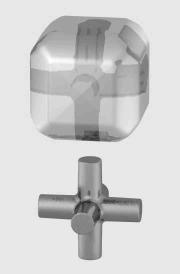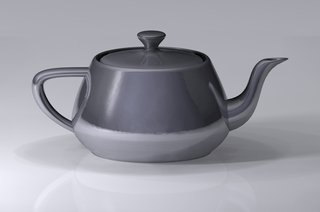
Computer-aided design (CAD) is the use of computers to aid in the creation, modification, analysis, or optimization of a design. This software is used to increase the productivity of the designer, improve the quality of design, improve communications through documentation, and to create a database for manufacturing. Designs made through CAD software are helpful in protecting products and inventions when used in patent applications. CAD output is often in the form of electronic files for print, machining, or other manufacturing operations. The terms computer-aided drafting (CAD) and computer aided design and drafting (CADD) are also used.
Pierre Étienne Bézier was a French engineer and one of the founders of the fields of solid, geometric and physical modelling as well as in the field of representing curves, especially in computer-aided design and manufacturing systems. As an engineer at Renault, he became a leader in the transformation of design and manufacturing, through mathematics and computing tools, into computer-aided design and three-dimensional modeling.
Computational geometry is a branch of computer science devoted to the study of algorithms which can be stated in terms of geometry. Some purely geometrical problems arise out of the study of computational geometric algorithms, and such problems are also considered to be part of computational geometry. While modern computational geometry is a recent development, it is one of the oldest fields of computing with a history stretching back to antiquity.

Solid modeling is a consistent set of principles for mathematical and computer modeling of three-dimensional shapes (solids). Solid modeling is distinguished from related areas of geometric modeling and computer graphics, such as 3D modeling, by its emphasis on physical fidelity. Together, the principles of geometric and solid modeling form the foundation of 3D-computer-aided design and in general support the creation, exchange, visualization, animation, interrogation, and annotation of digital models of physical objects.

In solid modeling and computer-aided design, boundary representation is a method for representing a 3D shape by defining the limits of its volume. A solid is represented as a collection of connected surface elements, which define the boundary between interior and exterior points.
Paul de Casteljau was a French physicist and mathematician. In 1959, while working at Citroën, he developed an algorithm for evaluating calculations on a certain family of curves, which would later be formalized and popularized by engineer Pierre Bézier, leading to the curves widely known as Bézier curves.
John Emory Dennis, Jr. is an American mathematician who has made major contributions in mathematical optimization. Dennis is currently a Noah Harding professor emeritus and research professor in the department of computational and applied mathematics at Rice University in Houston, Texas. His research interests include optimization in engineering design. He is the founder and editor-in-chief of the SIAM Journal on Optimization. In 2010, he was elected a Fellow of the Society for Industrial and Applied Mathematics.
Geometric modeling is a branch of applied mathematics and computational geometry that studies methods and algorithms for the mathematical description of shapes.

Lawrence Jay Rosenblum is an American mathematician, and Program Director for Graphics and Visualization at the National Science Foundation.

Computer graphics is a sub-field of computer science which studies methods for digitally synthesizing and manipulating visual content. Although the term often refers to the study of three-dimensional computer graphics, it also encompasses two-dimensional graphics and image processing. The individuals who serve as professional designers for computers graphics are known as "Graphics Programmers", who often are computer programmers with skills in computer graphics design.
Brian A. Barsky is a professor at the University of California, Berkeley, working in computer graphics and geometric modeling as well as in optometry and vision science. He is a Professor of Computer Science and Vision Science and an Affiliate Professor of Optometry. He is also a member of the Joint Graduate Group in Bioengineering, an inter-campus program, between UC Berkeley and UC San Francisco.

Geometrical design (GD) is a branch of computational geometry. It deals with the construction and representation of free-form curves, surfaces, or volumes and is closely related to geometric modeling. Core problems are curve and surface modelling and representation. GD studies especially the construction and manipulation of curves and surfaces given by a set of points using polynomial, rational, piecewise polynomial, or piecewise rational methods. The most important instruments here are parametric curves and parametric surfaces, such as Bézier curves, spline curves and surfaces. An important non-parametric approach is the level-set method.
Chandrajit Bajaj is an American computer scientist. He is a Professor of Computer science at the University of Texas at Austin holding the Computational Applied Mathematics Chair in Visualization and is the director of the Computational Visualization Center, in the Institute for Computational Engineering and Sciences (ICES).

In 3D computer graphics, 3D modeling is the process of developing a mathematical coordinate-based representation of any surface of an object in three dimensions via specialized software by manipulating edges, vertices, and polygons in a simulated 3D space.
Solid Modeling Solutions is a company who has an implementation of a mathematical representation of many NURBS, 3D geometry, and Solid modeling technology which emerged in the 1980s and 1990s into a commercial implementation known as SMLib. This article will provide the background and history of this implementation into a commercial product line from Solid Modeling Solutions (SMS). SMS is an independent supplier of source code for a powerful suite of 3D geometry kernels. SMS provides advanced NURBS-based geometry libraries, SMLib, TSNLib, GSNLib, NLib, SDLib, VSLib, and PolyMLib, that encompass extensive definition and manipulation of NURBS curves and surfaces with the latest fully functional non-manifold topology.
You-Dong Liang (梁友栋) is a mathematician and educator, best known for his contributions in geometric modeling and the Liang-Barsky algorithm.
Shape Data Limited is a computer software company in Cambridge, England that specialises in developing programs for engineering and manufacturing professionals.
Thomas W. Sederberg is the associate dean of the college of physical and mathematical sciences and professor of Computer Science at Brigham Young University in Provo, Utah. His research involves computer graphics and computer aided design. He helped invent free-form deformation and T-splines.
Designers have used computers for calculations since their invention. Digital computers were used in power system analysis or optimization as early as proto-"Whirlwind" in 1949. Circuit design theory or power network methodology was algebraic, symbolic, and often vector-based.






